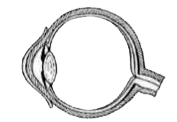Mention one difference between refraction in a prism and a glass slab.Solution in Kannada
In prism, during refraction, the incident ray is not parallel to the emerget ray as in a glass slab.
Topper's Solved these Questions
- THE HUMAN EYE AND THE COLOURFUL WORLDBOOK - ZEN PUBLICATIONCHAPTER - THE HUMAN EYE AND THE COLOURFUL WORLDEXERCISE - ZEN ADDITIONAL QUESTIONS SECTION - SHORT ANSWER TYPE QUESTIONS - I
66 Videos
- THE HUMAN EYE AND THE COLOURFUL WORLDBOOK - ZEN PUBLICATIONCHAPTER - THE HUMAN EYE AND THE COLOURFUL WORLDEXERCISE - ZEN ADDITIONAL QUESTIONS SECTION - SHORT ANSWER TYPE QUESTIONS - II
28 Videos
- THE HUMAN EYE AND THE COLOURFUL WORLDBOOK - ZEN PUBLICATIONCHAPTER - THE HUMAN EYE AND THE COLOURFUL WORLDEXERCISE - ZEN ADDITIONAL QUESTIONS SECTION (MULTIPLE - CHOICE QUESTIONS)
49 Videos
- SOURCES OF ENERGYBOOK - ZEN PUBLICATIONCHAPTER - SOURCES OF ENERGYEXERCISE - ZEN ADDITIONAL QUESTIONS SECTION (HIGHER-ORDER THINKING SKILLS [HOTS] )
14 Videos
Similar Questions
Name the four parts labelled as 1,2,3 and 4 in the given figure.

View SolutionDraw a labelled diagram of the human eye. What is the significance of the blind spot ?
View SolutionWhen light rays enter the eye, most of the refraction occurs at the
View SolutionState the areas where acid rains are most likely.
View SolutionAn equilateral glass prism can produce a minimum deviation of 30° to the path of an incident ray. A transpar- ent slab of refractive index 1.5 is placed in contact with one of the refracting faces of the prism. Thickness of the slab is 3 cm. Now calculate the minimum possible deviation which can be produced by this prism-slab combination.
View SolutionA parallel glass slab of refractive index sqrt3 is placed in contact with an equilateral prism of refractive index sqrt2 . A ray is incident on left surface of slab as shown. The slab and prism combination is surrounded by air. The magnitude of minimum possible deviation of this ray by slab-prism combination is:
View SolutionDifferentiate between a glass slab and a glass prism. What happens when a narrow beam of (i) a monochromatic light, and (ii) white light passes through (a) glass slab and (b) glass prism ?
View SolutionMention any four differences between a glass slab and a glass prism.
View SolutionThe equation ω=μv−μrμ−1 was derived for a prism having small refracting angle. Is it also valid for a prism of large refracting angle? Is it also valid for a glass slab or a glass sphere?
View SolutionWhy dispersoin by a glass prism but not by a glass slab?
View SolutionRefraction Through Glass Prism
View SolutionWhat is the difference between the displacement produced by a rectangular glass slab in a ray of light and the deviation produced by a glass prism?
View SolutionRefraction Through Glass Slab
View SolutionRefraction through Glass Prism
View Solutionकिसी काँच की प्रिज्म तथा काँच की स्लैब में हुए अपवर्तन में क्या अंतर है?
View Solution
